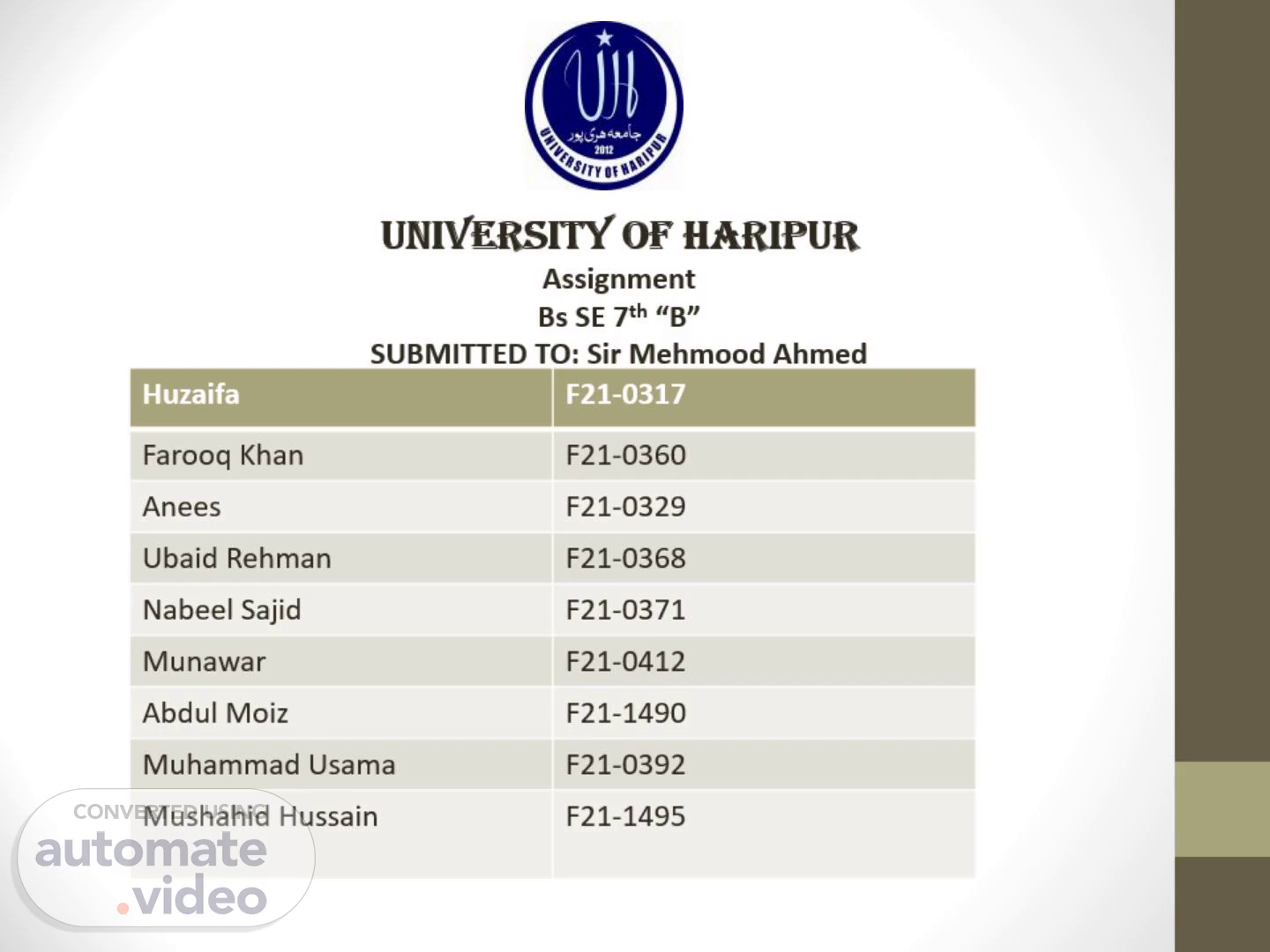Scene 1 (0s)
Huzaifa F21-0317 Farooq Khan F21-0360 Anees F21-0329 Ubaid Rehman F21-0368 Nabeel Sajid F21-0371 Munawar F21-0412 Abdul Moiz F21-1490 Muhammad Usama F21-0392 Mushahid Hussain F21-1495.
Scene 2 (15s)
Title : Build a website for the annual university fest..
Scene 3 (23s)
Unique Objective:- Goal: The primary purpose of the website is to provide a comprehensive and user-friendly platform for students to access all relevant information about the university fest. This includes details about events, tickets, venues, performers, and other essential aspects of the celebration. 2. Temporary Nature:- Start: The development of the website should commence approximately six months before the fest to ensure ample time for planning, design, development, and testing. This early start allows for effective promotion and ticket sales. End: The website's primary function will conclude a week before the fest. However, it may be retained for a short period afterward to serve as an archive and reference point for future events..
Scene 4 (55s)
3. Defined Scope:- Features:- The website must include essential features such as: Event Schedule: A detailed listing of all events, including dates, times, locations, and descriptions. Ticket Sales: An online ticketing system that allows students to purchase tickets conveniently. Venue Information: Maps, directions, and parking details for all venues. Guest Performers: Information about musicians, bands, and other performers. Sponsorship Details: Acknowledgement of sponsors and their contributions. Contact Information: Contact details for event organizers, helpdesk, and other relevant parties. Outside Scope:- The website's focus should be on providing information and facilitating participation. It should not involve the physical organization of the event or logistical arrangements..
Scene 5 (1m 27s)
4. Specific Resources:- People: A team of qualified professionals, including web developers, designers, and content writers, will be required to create and maintain the website. Budget: Adequate funding must be allocated to cover the costs of website development, hosting, domain registration, and other related expenses. Tools: Appropriate software tools, such as design software and content management systems, will be necessary for efficient development and management. Time: A realistic timeline should be established to ensure that the website is completed and ready for launch well before the fest. 5. Uncertainty and Risk:- Technical Issues: Websites are prone to technical difficulties, such as crashes, security breaches, and compatibility problems. It is essential to have contingency plans in place to address these issues promptly. Content Delays: Obtaining accurate and timely information from event organizers and performers can be challenging. Effective communication and coordination are crucial to avoid delays. Design Challenges: Meeting the expectations of the university and students regarding the website's aesthetics and functionality can be demanding. Collaboration between designers and stakeholders is essential to achieve a satisfactory outcome..
Scene 6 (2m 14s)
6. Cross-Functional Collaboration:- Teams: The website development project should involve representatives from various teams, including the event planning committee, marketing team, and IT department. Collaboration: Regular meetings, shared documents, and clear communication channels are essential to ensure effective collaboration and alignment between teams. 7. Progressive Elaboration:- Potential Additions: Based on user feedback and evolving needs, the website may be enhanced with additional features such as: Interactive Map: A map of the fest grounds with interactive elements. Social Media Integration: Integration with social media platforms to facilitate sharing and engagement. Mobile App Companion: A mobile app that provides the same functionality as the website..
Scene 7 (2m 44s)
8. Change-Focused:- Impact: The website has the potential to significantly improve the overall fest experience for students by providing a centralized and user-friendly platform for information and participation. 9. Performance Criteria:- Key Performance Indicators: The success of the website can be measured by various key performance indicators, including: Website Traffic: The number of visitors to the website. User Engagement: The time spent on the website and the interaction with its content. Ticket Sales: The number of tickets sold through the website. Positive Feedback: Feedback from students and other stakeholders regarding the website's usefulness and effectiveness..
